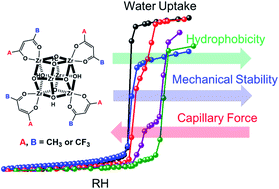Insights into dual-functional modification for water stability enhancement of mesoporous zirconium metal–organic frameworks†
Abstract
The stability of metal–organic frameworks (MOFs) in water affects their ability to function as chemical catalysts, their capacity as adsorbents for separations in water vapor presence, and their usefulness as recyclable water harvesters. Here, we have examined water stability of four node-modified variants of the mesoporous MOF, NU-1000, namely formate-, Acac-, TFacac-, and Facac-NU-1000, comparing these with node-accessible NU-1000. These NU-1000 variants present ligands grafted to NU-1000's hexa-Zr(IV)-oxy nodes by displacing terminal aqua and hydroxo ligands. Facac-NU-1000, containing the most hydrophobic ligands, showed the greatest water stability, being able to undergo at least 20 water adsorption/desorption cycles without loss of water uptake capacity. Computational studies revealed dual salutary functions of installed Facac ligands: (1) enhancement of framework mechanical stability due to electrostatic interactions; and (2) transformation and shielding of the otherwise highly hydrophilic nodes from H-bonding interactions with free water, presumably leading to weaker channel-stressing capillary forces during water evacuation – consistent with trends in free energies of dehydration across the NU-1000 variants. Water harvesting and hydrolysis of chemical warfare agent simulants were examined to gauge the functional consequences of modification and mechanical stabilization of NU-1000 by Facac ligands. The studies revealed a harvesting capacity of ∼1.1 L of water vapor per gram of Facac-NU-1000 per sorption cycle. They also revealed retention of catalytic MOF activity following 20 water uptake and release cycles. This study provides insights into the basis for node-ligand-engendered stabilization of wide-channel MOFs against collapse during water removal.



 Please wait while we load your content...
Please wait while we load your content...